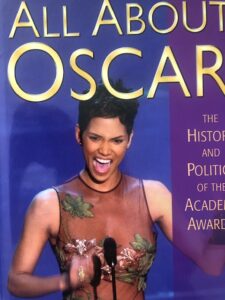In 1941, Howard Hawks made two vastly different films, both starring Gary Cooper: The delicious screwball comedy Ball of Fire and the simpler, patriotic biopic Sergeant York.
Grade: A- (**** out of *****)

Oscar being Oscar, Hawks received his one and only Best Director nomination for the lesser effort, Sergeant York, for political if not artistic reasons; the country was then at war.
In Charles Brackett and Billy Wilder’s smart script, Gary Cooper plays Bertram Potts, a professor who’s engaged in writing a treatise on slang for an encyclopedia.
For research purposes only, Potts elicit the assistance of a burlesque stripper named Sugarpuss O’Shea (Barbara Stanwyck at her sexiest).
Miss O’Shea, hip to the last syllable of current slang, moves in with the professor and his seven scholarly associates, when the law starts moving in on her.
O’Shea’s presence upsets the stodgy lives of the rather stuffy gentlemen and their housekeeper, and the regulated existence to which they are accustomed. However, they soon take Sugarpuss to their hearts and, more practically, her dialogue down on paper. When it eventually comes time for her to leave her hideaway and marry her gangster boyfriend Joe Lilac (Dana Andrews, miscast), she balks because, by this time, she has fallen for the professor.
There is strong chemistry between Cooper and Stanwyck, who in the same year also appeared in Frank Capra’s moralistic but compromised Depression era saga, “Meet Joe Doe.” When Billy Wilder became a director, in the mid-1940s, he cast both Cooper and Stanwyck in several of his pictures, going on record saying that Stanwyck was the most professional actress he had worked with in Hollywood.
There are not many overt political statements in Wilder’s films, but there are allusions and references. The director often poked fun at those who took politics too seriously. For example, in this film, burlesque queen ‘Sugarpuss’ points at her sore throat and complains “Pink? It’s as red as the Daily Worker and twice as sore.” Later on. she gives the overbearing housemaid the name of “Franco.”
In 1948, Samuel Goldwyn and helmer Howard Hawks remade the comedy as a vehicle for Danny Kaye, titled A Song Is Born, which is not nearly as entertaining as the original.
Oscar Alert
Oscar Nominations: 4
Actress: Barbara Stanwyck
Original Story: Thomas Monroe and Billy Wilder
Sound Recording: Thomas Moulton
Scoring of a Dramatic Picture: Alfred Newman
Oscar Awards: None
Oscar Context:
In 1941, the Best Actress Oscar went to Joan Fontaine for “Suspicion,” the Screenplay to Harry Segall for “Here Comes Mr. Jordan,” the Sound Oscar to “That Hamilton Woman,” and the Scoring Oscar to Bernard Herrmann for “All That Money Can Buy.”
Credits
A Samuel Goldwyn Production.
Released by RKO-Radio Pictures, Inc.
Director: Howard Hanks.
Producer: Samuel Goldwyn.
Scenarists: Charles Brackett, Billy Wilder.
Photographer: Gregg Toland.
Editor: Daniel Mandell.
Musical Score: Alfred Newman.
Art Director: Perry Ferguson.
Sound Recorder: Thomas T. Moulton.
Set Decorator: Julia Heron.
Song: “Drum Boogie” by Gene Krupa and Roy Eldridge.
Based on “From A to Z,” an original story, by Thomas Monroe and Billy Wilder.
Release date: December 2, 1941
Running time 111 minutes
Box office $2,641,000 (worldwide rentals)











